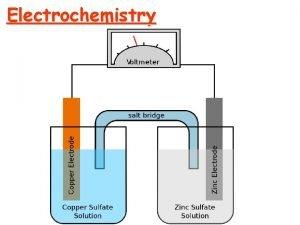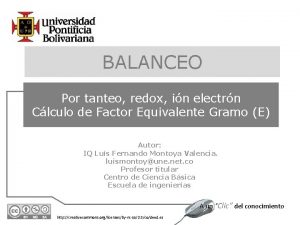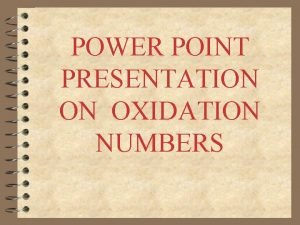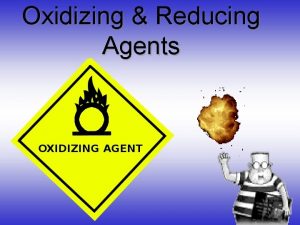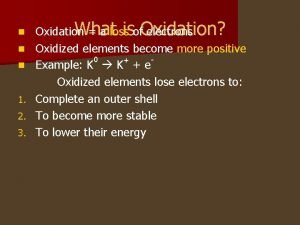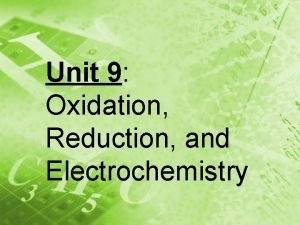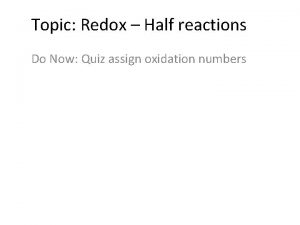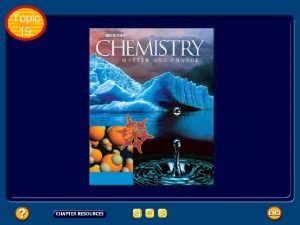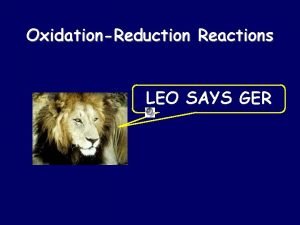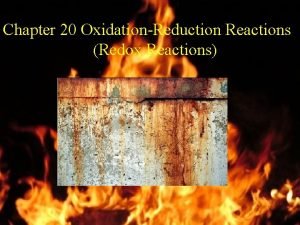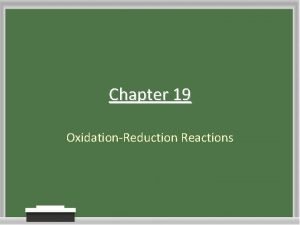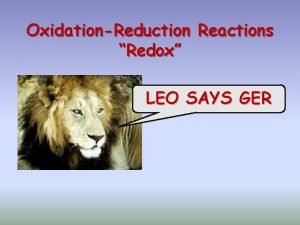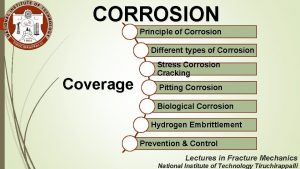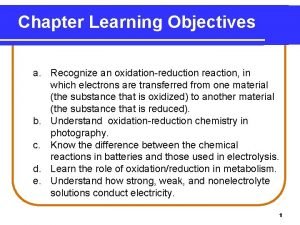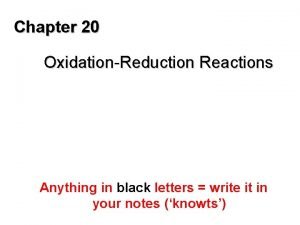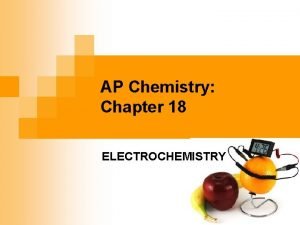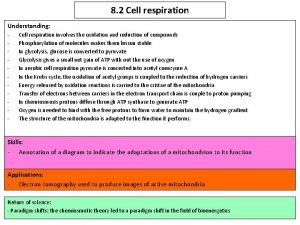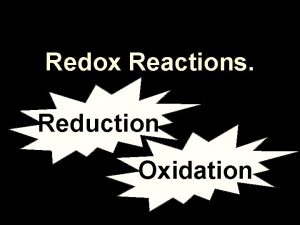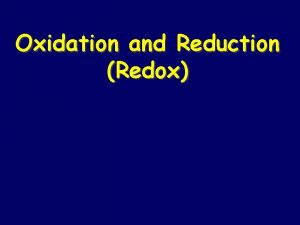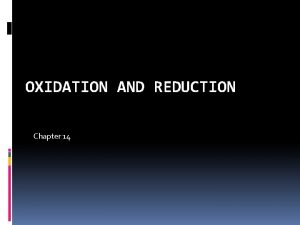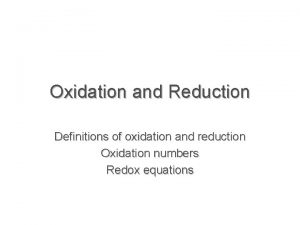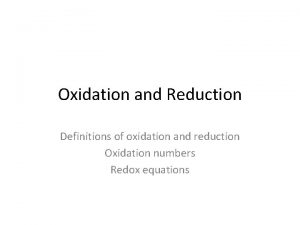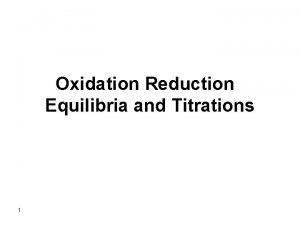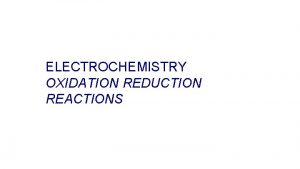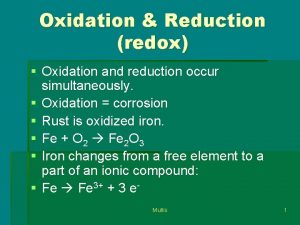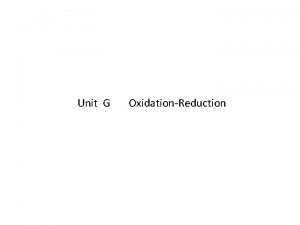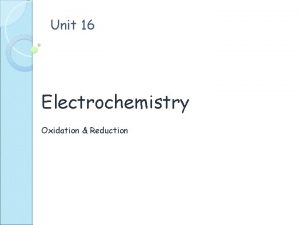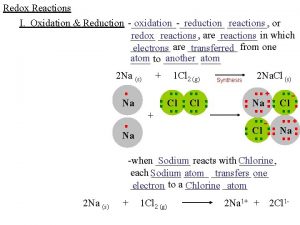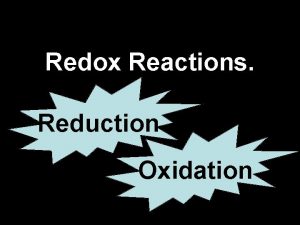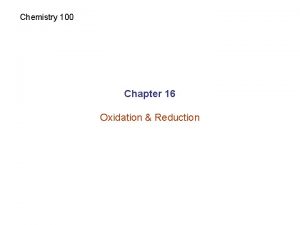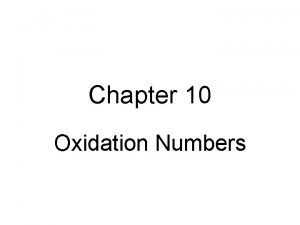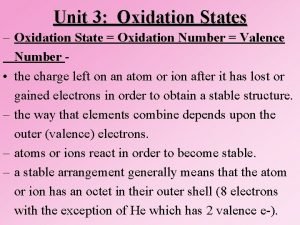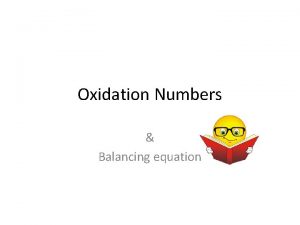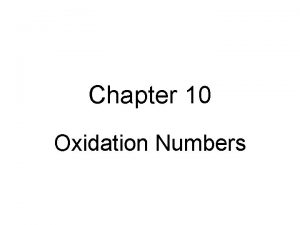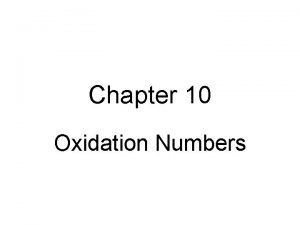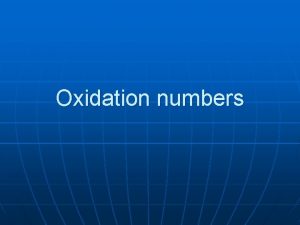Chemistry 200 Fundamental G Oxidation Reduction Oxidation and

























- Slides: 25

Chemistry 200 Fundamental G Oxidation & Reduction

Oxidation and Reduction reactions (redox) e 2 Na(s) + Cl 2(g) 2 Na. Cl(s) Na → Na+ + e. Cl + e- → Cl-

Oxidation and Reduction reactions (redox) oxidation: it is the loss of electrons. Na → Na+ + ereduction: it is the gain of electrons. Cl + e- → Cl- Remember – LEO says GER. Loss of Electrons is Oxidation Gain of Electrons is Reduction.

Oxidation and Reduction reactions (redox) Metal + Nonmetal : Transfer of electrons Oxidation and Reduction reactions (redox) Oxidation and reduction always occur together. (The lost e- must go somewhere!)

Oxidation and Reduction reactions (redox) oxidation: it is the loss of electrons. reduction: it is the gain of electrons. Zn(s) + Cu 2+(aq) Zn 2+(aq) + Cu(s) redox reaction Zn(s) Zn 2+(aq) + 2 e- Zn is oxidized (reducing agent) Cu 2+(aq) + 2 e- Cu(s) Cu 2+ is reduced (oxidizing agent)

Oxidation and Reduction reactions (redox) oxidation: is the gain of oxygen / loss of hydrogen. reduction: is the loss of oxygen / gain of hydrogen. CH 4(s) + 2 O 2(g) CO 2(g) + 2 H 2 O(g) C gains O and loses H is oxidized (reducing agent) redox reaction O gains H Is reduced (oxidizing agent) single replacement reaction and combustion reactions redox reactions double replacement reactions non redox

Oxidation and Reduction reactions (redox) Example 2: • 2 Al(s) + Fe 2 O 3(s) 2 Fe(s) + Al 2 O 3(s) is oxidized is reduced • Called the Thermite reaction. • Let’s just say it’s vigorous!

Oxidation and Reduction reactions (redox) Example 3: Cu(s) + 2 Ag+(aq) 2 Ag(s) + Cu 2+(aq) is oxidized is reduced

Oxidation and Reduction reactions (redox) Example 4: Zn(s) + 2 HCl(aq) H 2(g) + Zn. Cl 2(aq) Zn(s) + 2 H+(aq) + 2 Cl-(aq) H 2(g) + Zn 2+(aq) + 2 Cl-(aq) Zn(s) + 2 H+(aq) H 2(g) + Zn 2+(aq) is oxidized is reduced Note: this reaction also shows the fourth driving force of a reaction, namely, the formation of a gas.

Oxidation and Reduction reactions (redox) Example 5: 2 Mg(s) + O 2(g) 2 Mg. O(s) is oxidized is reduced

Oxidation States (Oxidation numbers) Assigning charges to the various atoms in a compound. Keep track of electrons in redox reactions.

Rules for assigning oxidation states 1. Charge (oxidation state) of a uncombined element is zero. H 2, Cl 2, Ar, Na, K 2. The oxidation state of a monatomic ion is the same as its charge. Na. Cl Al 2 S 3 Na: +1 Cl: -1 Al 3+ S 2 - Al: +3 S: -2

Rules for assigning oxidation states For covalent compounds assume the most electronegative atom controls or possesses the shared electrons. 2 e- H H O 2 e- O gained two e- from H → Oxidation state = -2 H lost one e- → Oxidation state = +1 3. The oxidation state of H is +1 and O is -2 in covalent compounds. Exception: Peroxide (O 22 -) = -1 H 2 O 2

Rules for assigning oxidation states 4. Sum of oxidation states = 0 in a neutral compound. SO 2 x + 2 × (-2) = 0 x + (-4) = 0 x = +4 NH 3 x + 3 × (+1) = 0 x + (+3) = 0 N = -3

Rules for assigning oxidation states The most electronegative elements: F, O, N, and Cl F: -1, O: -2, N: -3, Cl: -1 5. If two of these elements are found in the same compound, we assign them in order of electronegativity. F ˃ O ˃ N ˃ Cl NO 2 x + 2 × (-2) = 0 x + (-4) = 0 x = +4 So N must be +4

Rules for assigning oxidation states 6. Sum of oxidation states = charge in an ion. x + 3 × (-2) = -1 NO 3 - x + (-6) = -1 x = +5 So N must be +5 SO 42 - x + 4 × (-2) = -2 x + (-8) = -2 x = +6 So S must be +6

Rules for assigning oxidation states K 2 Cr 2 O 7 K = +1; Cr = +6; O = – 2 CO 32 - C = +4; O = – 2 Mn. O 2 Mn = +4; O = – 2 PCl 5 P = +5; Cl = – 1 SF 4 S = +4; F = – 1

Oxidation-Reduction Reactions In some redox reactions are produced. e 2 Na(s) + Cl 2(g) 2 Na. Cl(s) Oxidation state: 0 +1 -1 Element Na + Cl-

Oxidation-Reduction Reactions In some redox reactions are not produced (all nonmetals). CH 4(g) + 2 O 2(g) CO 2(g) + 2 H 2 O(g) Oxidation state: -4 +1 (each H) +4 -2 (each O) 0 CH 4 → CO 2 + 8 e-4 +4 2 O 2 + 8 e- → CO 2 + 2 H 2 O 0 4(-2) = -8 +1 (each H) -2 C is oxidized. CH 4 is a reducing agent. O is reduced. O 2 is an oxidizing agent.

Oxidation-Reduction Reactions Oxidation: is an increase in oxidation state (a loss of e-). Reduction: is a decrease in oxidation state (a gain of e-). Oxidizing agent (electron acceptor): the reactant containing the element that is reduced. Reducing agent (electron donor): the reactant containing the element that is oxidized. CH 4 → CO 2 + 8 e- C is oxidized. CH 4 is a reducing agent. 2 O 2 + 8 e- → CO 2 + 2 H 2 O O is reduced. O 2 is an oxidizing agent.

Half-Reaction Method for balancing Ce 4+(aq) + Sn 2+(aq) → Ce 3+(aq) + Sn 4+(aq) Ce 4+(aq) + e- → Ce 3+(aq) Reduction half-reaction Sn 2+(aq) → Sn 4+(aq) + 2 e- Oxidation half-reaction Number of Electrons lost Multiply by 2: must be equal to Number of Electrons gained 2 Ce 4+(aq) + 2 e- → 2 Ce 3+(aq) Sn 2+(aq) → Sn 4+(aq) + 2 e- 2 Ce 4+(aq) + Sn 2+(aq) + 2 e- → 2 Ce 3+(aq) + Sn 4+(aq) + 2 e 2 Ce 4+(aq) + Sn 2+(aq) → 2 Ce 3+(aq) + Sn 4+(aq)

Half-Reaction Method for balancing 1. Identify and write the equations for the oxidation and reduction half –reactions. 2. For each half–reaction: A. Balance all the elements except H and O. B. Balance O using H 2 O. C. Balance H using H+. D. Balance the charge using electrons. 3. If necessary, multiply one or both balanced half–reactions by an integer to equalize the number of electrons transferred in the two half–reactions. 4. Add the half–reactions, and cancel identical species. 5. Check that the elements and charges are balanced.

Half-Reaction Method for balancing Cr 2 O 72 -(aq) + SO 32 -(aq) Cr 3+(aq) + SO 42 -(aq) How can we balance this equation? 1. Separate into half-reactions. 2. Balance elements except H and O. Cr 2 O 72 -(aq) 2 Cr 3+(aq) SO 32 -(aq) SO 42 -(aq)

Half-Reaction Method for balancing 3. Balance O’s with H 2 O and H’s with H+. 14 H+(aq) + Cr 2 O 72 -(aq) 2 Cr 3+(aq) + 7 H 2 O(aq) + SO 32 -(aq) SO 42 -(aq) + 2 H+(aq) 4. How many electrons are involved in each half-reaction? Balance the charges. 6 e- + 14 H+(aq) + Cr 2 O 72 -(aq) 2 Cr 3+(aq) + 7 H 2 O(aq) + SO 32 -(aq) SO 42 -(aq) + 2 H+(aq) + 2 e-

Half-Reaction Method for balancing 5. Multiply whole reactions by a whole number to make the number of electrons gained equal the number of electrons lost. 6 e- + 14 H+(aq) + Cr 2 O 72 -(aq) 2 Cr 3+(aq) + 7 H 2 O(aq) 3 × ( H 2 O(aq) + SO 32 -(aq) SO 42 -(aq) + 2 H+(aq) + 2 e- ) 6. Combine half-reactions cancelling out those reactants and products that are the same on both sides, especially the electrons. 8 4 + 23+ 6 e- + 14 H (aq) + Cr 2 O 7 (aq) 2 Cr (aq) + 7 H 2 O(aq) 3 H 2 O(aq) + 3 SO 32 -(aq) 3 SO 42 -(aq) + 6 H+(aq) + 6 e. Cr 2 O 72 - + 3 SO 32 - + 8 H+ 2 Cr 3+ + 3 SO 42 - + 4 H 2 O
 200+200+300
200+200+300 Reduction oxidation
Reduction oxidation Electrochemistry equations
Electrochemistry equations What are redox reactions examples
What are redox reactions examples Balanceo por redox
Balanceo por redox Explain oxidation
Explain oxidation Reducing agent
Reducing agent How to know oxidation and reduction
How to know oxidation and reduction Which identifies an oxidation-reduction reaction?
Which identifies an oxidation-reduction reaction? Oxidation-reduction quiz
Oxidation-reduction quiz Which equation represents an oxidation-reduction reaction
Which equation represents an oxidation-reduction reaction Leo says ger
Leo says ger Oxidation half reaction
Oxidation half reaction Chapter 19 review oxidation-reduction reactions
Chapter 19 review oxidation-reduction reactions Chapter 20 oxidation-reduction reactions answer key
Chapter 20 oxidation-reduction reactions answer key Chapter 20 milady
Chapter 20 milady Chapter 19 review oxidation-reduction reactions answers
Chapter 19 review oxidation-reduction reactions answers Leo ger oxidation reduction
Leo ger oxidation reduction Corrosion oxidation or reduction
Corrosion oxidation or reduction Oxidation–reduction reactions
Oxidation–reduction reactions Leo goes ger
Leo goes ger Oxidation–reduction reactions
Oxidation–reduction reactions Leo the lion goes ger
Leo the lion goes ger Ap chemistry ced
Ap chemistry ced Respirometer
Respirometer Red cat redox
Red cat redox


